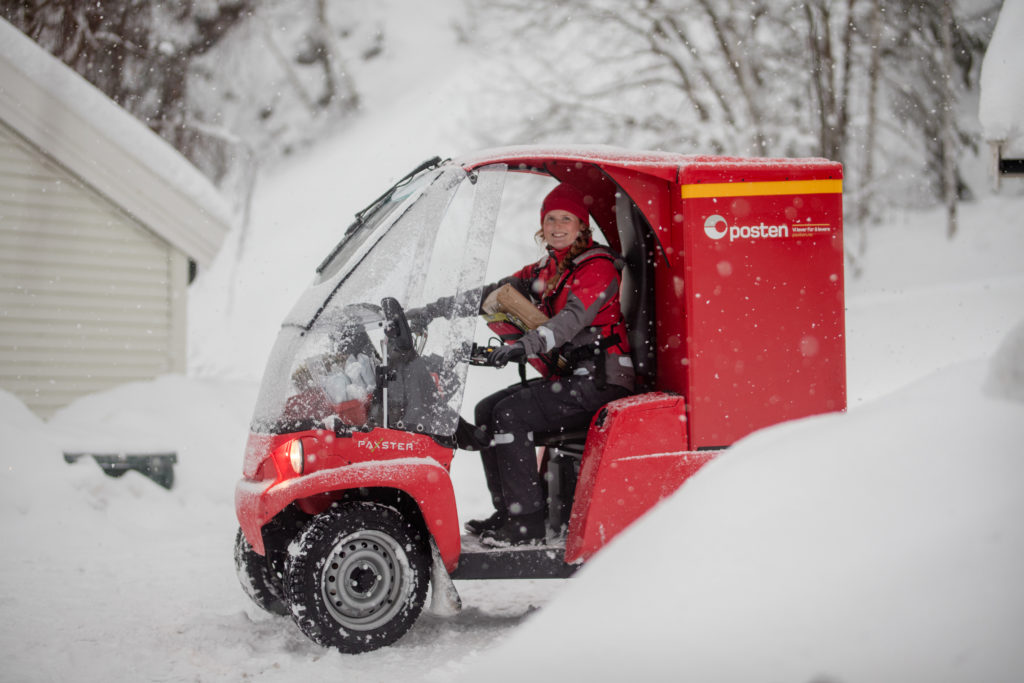Posten Norge is implementing electric vehicles at scale. Marek Różycki (Last Mile Experts) and Ian Kerr (Postal Hub Podcast) take a special look at how the post is doing it, and offer some key tips for other posts and parcel companies looking to follow suit
Nordic countries have a growing reputation for being environmentally aware. Following our recent article about the electric future for delivery vehicles, we look at how Posten Norge (Norway Post) is implementing electric vehicles (EVs) at scale, making the last mile cleaner and more effective.
There is a lot of noise being made by posts and carriers about moving to, or at least testing, EVs, and the growing portfolio of EVs is promising for an industry that has a large carbon footprint and is fighting for efficiency. However, the reality is that targets for EV implementation are often set years into the future and may change. We believe that even with current technology an electric fleet can be successfully implemented for many operators with urban coverage.
Posten Norge started looking at electric vehicles in 2010, at a time where there weren’t many options to choose from. It had a delivery fleet of 4,500 diesel vans, comprising 96% of the fleet. Its EV story started with the realization that a diesel van wasn’t suited to all types of route.
“We defined a fairly simple vehicle strategy that we would use for future implementation,” says Gunnar Inderberg, head of operational development at Posten Norge. “We separated routes into city center, suburban and rural. All had different characteristics with regard to number of stops, distance traveled, weight/volume carried, etc.”
Based on this analysis, it became easier to see what kind of vehicle fits where. Postal delivery in city centers is generally characterized by a medium number of stops but with multiple delivery points (due to blocks of flats), fairly low kilometers traveled and poor parking availability. Suburban areas have more stops (more single houses) and a medium range of kilometers traveled per route. Rural routes have relatively few stops, but a large number of kilometers traveled.
What Posten saw was that by replacing combustion vehicles in city centers and suburban areas it could improve productivity. There was no ‘one size fits all’ option, though. For city centers, electric trolleys and eBikes made sense, but for suburban areas range often became an issue and larger, more powerful EVs were needed.
Let’s look at more detail here. Many posties were making 300+ stops per route, which took a lot of time with a car (drive up to the mailboxes, brake, park, pick the mail, get out of the car, walk to the mail box) but with smaller/lighter vehicles without doors, they could access the mailbox faster. Posten actually saw time savings of up to 15% here.
This was the background for embarking on a major electrification initiative with Paxster, which produces a niche vehicle for postal and logistics deliveries, and larger EVs such as the Renault Kangoo and Peugot Partner. Today Posten has more than a 1,000 EVs in the fleet (about a third the total) and this number is growing.
“Our EV policy has reduced annual CO2 emissions by 40% over the past few years,” says Inderberg. “We have an ambition of increasing the electric ratio even more, but with current battery technology we can’t cover all routes.”
So what are the main learnings we can share with you? Here are our 10 commandments for successful EV implementation:
• Don’t limit yourself to a 1:1 swap with current routes/vehicles. Adjust routes to make them suitable – for example, only 80% of a current route could be suitable for an EV – then restructure the route to capture the operational savings
• Look at creative ways of extending the range – for example, use fast chargers in the lunch break, try solar ‘top up’ panels on the roof, or perhaps additional battery packs for less dense, longer routes
• Remember that most manufacturers’ declared capabilities will be optimistic, especially on very hot or cold days (when the battery is least effective or under most pressure – or when the heating or air conditioning is on full blast)
• At first, drivers will suffer from ‘range anxiety’ and may return without completing a route for fear of running out of juice. Let them run the full route. If properly planned and operated, they’ll succeed; if not, replan the route and/or train the driver
• Create competition among staff to get the most out of the EVs; range is heavily impacted by driving behavior. Electric vehicles are often lighter than the vehicles they replace, with different handling, so staff engagement is important
• You need to have a good (local) servicing infrastructure in place for maintenance of electric vehicles
• You need to have pre-planned and installed suitable and diverse charging facilities. They can be costly to install and should be part of the total cost of ownership evaluation
• EVs make less noise, so drivers should be even more careful when driving, especially in residential areas. Some EVs have artificial engine noise to deal with this issue
• Once drivers pass the initial skepticism toward EVs they become a preferred choice as EVs are often easier and more convenient to drive. Also, it’s important for customers, the media and the general public from a corporate social responsibility viewpoint
• Environmental and economic targets may be achieved simultaneously if implementation is right
The Posten Norge example has helped us see that good planning, flexibility in route management and understanding of the various types of EVs and their relative merits is key to any successful project aimed at electrifying the last mile. The benefits are clear, with labor efficiency gains of up to 15% and a dramatic cut in carbon footprint (assuming there is clean electricity in your country). In addition, EVs will have 10-20% of the fuel cost of a combustion engine and much lower service costs/maintenance stops. EVs are still relatively expensive, but subsidies in many countries help reduce this imbalance.
It seems, then, that the writing is on the wall: EVs are coming and those who are first to implement a green last mile effectively will benefit financially and have a better image with customers and the public at large. Well done Posten for being at the cutting edge here!
Bios

Ian Kerr is the founder and host of the Postal Hub Podcast, the weekly podcast for the postal and delivery sectors.

Marek Różycki is managing partner at Last Mile Experts, specializing in CEP and e-commerce last-mile advisory.
Ian Kerr will moderate the conference workshops PUDOs & Lockers: the New Power in the Last Mile and Social Media & Communications at Parcel+Post Expo Conference 2019. Marek Różyck will moderate the panel Intelligent Self-Service Solutions and the PUDOs & Lockers: the New Power in the Last Mile workshop.


